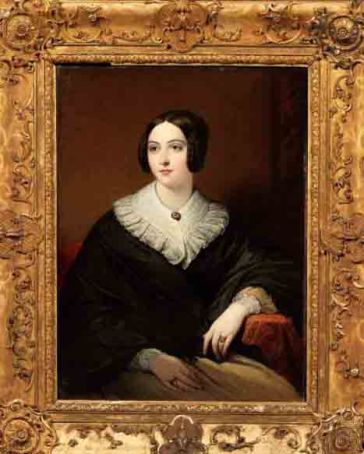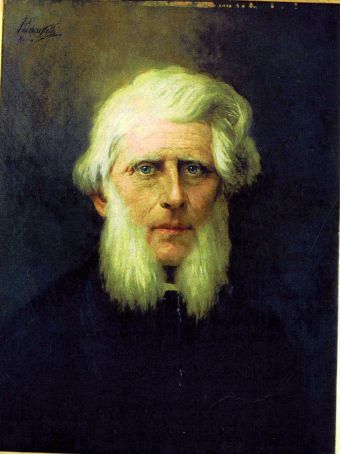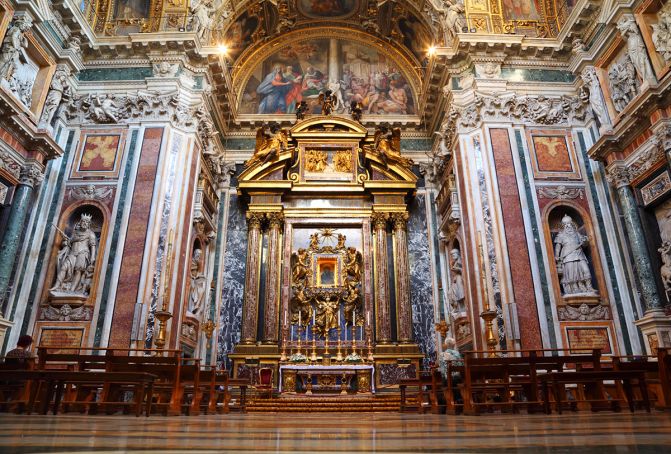Lady Gwendoline Talbot was known as “La Madre dei Poverelli” for her tireless charity work and ministry to Rome's sick.
Lady Gwendoline Talbot married Prince Marcantonio V Borghese in Rome on 11 May 1835.Cardinal Thomas Weld, England’s first cardinal since the granting of Catholic Emancipation in 1829, officiated at the ceremony in his apartments at the Odescalchi palace in Piazza dei Dodici Apostoli. Cardinal Weld was a cousin of the bride’s father, John Talbot, who became 16th Earl of Shrewsbury in 1827.
The Talbots
One of Britain’s leading Roman Catholic families, the Talbots succeeded in retaining their lands during the Reformation. In 1814 the future Earl John married Maria Theresa Talbot of Castle Talbot, County Wexford, Ireland. They had a son who died in infancy and two daughters, Mary Alathea Beatrix, born in 1815, and Catherine Gwendoline, born two years later.
Talbot became friendly with the architect Augustus Pugin – known for designing the clock tower housing Big Ben and the interior of the Houses of Parliament – who converted to Catholicism soon after meeting him.
Pugin rebuilt the Talbot residence at Alton Abbey Staffordshire, renamed Alton Towers, and made a profitable career in designing Catholic churches in the wake of Catholic Emancipation. Shrewsbury contributed to the cost of building many of these, earning the sobriquet of the “Good Earl John” as a result.
Travels in Europe
In addition to providing his daughters with an exemplary Catholic formation at home, Shrewsbury was also convinced of the educational value of travel. The Talbots accordingly spent much of the winter on the Continent and the two girls acquired proficiency in French, German and Italian.
As members of one of Britain’s leading Catholic families, they were feted by European aristocracy everywhere they went. Mary Alethea Beatrix was created a princess by King Ludwig 1 of Bavaria, and married Prince Filippo Doria in 1832.

Gwendoline, who had been described by the British monarch King William IV (1830-1837) as “the greatest beauty in the realm,” was particularly taken with Rome. At a masked ball where she appeared as Lalla-Rookh, the heroine of the oriental romance by Thomas Moore, the Irish poet and friend of Lord Byron, she caught the eye of Marcantonio Borghese who soon afterwards asked for her hand and was granted permission to marry her.
Gwendoline’s marriage brought her into the highest echelons of Roman society. A famous brooch worn by Gwendoline was made from the tiara of the notorious Pauline Bonaparte, sister of Napoleon and wife of her brother-in-law Camillo.
Artistocratic circles
Yet, despite her close involvement in aristocratic circles, there are strong indications that she was strangely detached from the frivolous aspects of this elegant lifestyle. In 1837 when Princess Gwendoline was sitting for a portrait by a Roman artist named Collati, he asked her to wear a black velvet dress.
Gwendoline replied that the dress she was wearing would have to do. Collati then asked her to don her Turkish shawl, but it transpired that she had it given it away and was finally forced to borrow a shawl from one of her servants to satisfy the artist.
READ ALSO
Princess Gwendoline came into her own in the aftermath of the cholera epidemic that ravaged the Eternal City in 1837. That year 9,752 victims were struck by the disease in Rome with 5,479 deaths, in a city with little more that 150,000 inhabitants. The epidemic lasted from the end of July until 15 October, when crowds flocked to S. Maria Maggiore to celebrate the end of the pestilence.It was with great reluctance that the princess withdrew with her family to their home in Frascati, Villa Mondragone, during those summer months to avoid the danger of contagion. On her return, however, she threw herself immediately into relief work among the survivors, her prime concern being the infants orphaned by the plague.
Rome's poor and destitute
She engaged the well-off families of Rome to help her and visited the homes of the poor and destitute, bringing food, clothes and medicine to the needy. She had no qualms about washing, cleaning and feeding them, sometimes slipping out of the Palazzo Borghese in disguise to conceal her movements. This led to some embarrassing moments. On one occasion she was followed by a member of the papal bodyguard, intrigued by her gracious but mysterious aura.
Though somewhat abashed by his proposals, the princess nonetheless stood her ground and invited the gallant into the humble dwelling she was visiting. Taken aback at the sight of the haggard mother and children who warmly greeted the princess as their benefactor, the young dandy was shamed into leaving a generous offering for their upkeep before he hastily withdrew.

City in mourning
The whole city was plunged into grief at the news of Princess Gwendoline’s death. On the night of 30 October the funeral cortege left the Borghese Palace and, followed by massive crowds, made its way along the Corso, Piazza Venezia and the Baths of Trajan before turning left up the slopes of the Quirinal hill. The procession halted at the Palazzo Quirinale, where Pope Gregory XVI came to his balcony and blessed the remains. Declaring that her death was a public calamity, he gave orders that the great portal of S. Maria Maggiore be opened, a privilege reserved for the noblest Roman families.
Bearing the inscription: Qui riposano le ceneri della madre dei poverelli, la Principessa Guendolina Borghese, Nata a Londra, dal conte de Shrewsbury, morta a 22 anni, il 27 ottobre 1840, the princess’s coffin was interred in the family vault below the altar in the Borghese Chapel in S. Maria Maggiore.

The orator claimed that Gwendoline’s only fault was to have been liberal beyond her ample means and continued as follows: "Her private fortune was entirely devoted to the poor; and for their sake she sometimes contracted debts, which were generously paid by the Prince her husband, who admired and encouraged her benevolence."
Borghese crypt
When you next enter the Basilica of S. Maria Maggiore take note of the icon above the high altar, the Salus Populi Romani, an image of the Virgin Mary that was carried through the streets of Rome for the first time in over 200 years during the cholera epidemics of 1835 and 1837.
Spare a thought too for the young princess who lies buried in the Borghese crypt below the altar, a lady whose devotion to the survivors of the epidemic was such that she earned the title, mother of the poor.
Article by Mícheál MacCraith
This article was published in the January 2020 edition of Wanted in Rome magazine.
General Info
View on Map
Princess Gwendoline: Rome's Mother of the Poor
Piazza di S. Maria Maggiore, 00100 Roma RM, Italy

















